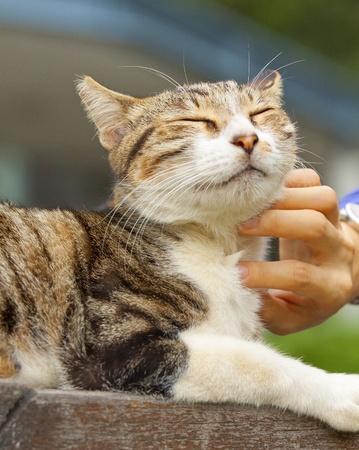1. Understanding Cat Biting: An Overview
If youve ever wondered, “Why does my cat bite?” youre not alone. Cat biting is a common concern for pet parents in the U.S., and understanding the reasons behind this behavior can help you respond appropriately. Cats use their mouths to communicate many different things, and not all biting is the same. Let’s explore the main types of cat biting and what each might mean.
Types of Cat Biting
| Type of Biting | What It Means | Common Signs |
|---|---|---|
| Playful Biting | Your cat is trying to play or get your attention in a fun way. | Gentle nibbles, pouncing, playful body language, no hissing or growling. |
| Defensive Biting | Your cat feels threatened or scared and is trying to protect itself. | Ears back, hissing, growling, body crouched or puffed up, quick bites. |
| Attention-Seeking Biting | Your cat wants your focus—maybe its hungry or just wants to be noticed. | Nips at hands or feet when you’re not paying attention, follows you around, meows before biting. |
| Overstimulation Biting | Your cat gets too excited from petting or play and needs a break. | Twitching tail, flattened ears, restlessness before biting during petting sessions. |
| Pain-Induced Biting | Your cat may be hurting somewhere and reacts with a bite when touched. | Bites when touched in specific areas, hides more often, shows signs of discomfort. |
Why Do Cats Bite?
Cats bite for several reasons, and it’s important to remember that this is part of their natural behavior. In the wild, cats use biting as a way to hunt, defend themselves, and communicate boundaries. Domestic cats carry these instincts into our homes. Sometimes they bite gently while playing; other times it might be a warning that they’ve had enough petting or feel anxious.
Understanding Body Language
Paying attention to your cats body language is key to figuring out why theyre biting. Are their ears back? Is their tail flicking? Do they seem relaxed or tense? These clues can help you know whether your cat is being playful or if something else is going on.
2. Common Reasons Why Cats Bite
Cats might bite for a variety of reasons, and understanding what triggers this behavior can help you respond appropriately. Here are some of the most common motivations behind feline biting:
Overstimulation
Sometimes, petting or playing with your cat can lead to sudden bites. This often happens when a cat becomes overstimulated or overly excited. Even gentle stroking can become too much, especially around sensitive areas like the belly or tail.
Fear
If a cat feels threatened, scared, or cornered, biting is one way they defend themselves. Changes in environment, loud noises, or unfamiliar people can trigger fear-based biting.
Pain
Biting may also be a response to pain. If your cat suddenly starts biting during petting or handling, it could be their way of telling you that something hurts. Always consider a vet check-up if biting is new or out of character for your cat.
Territorial Instincts
Cats are naturally territorial animals. They may bite to protect their space from other pets or even from humans if they feel their territory is being invaded.
Redirected Aggression
This type of biting occurs when a cat is agitated by something they cant reach—like seeing another animal outside—and then lashes out at whoever is closest, which could be you.
Quick Reference Table: Reasons for Cat Biting
| Reason | What Triggers It? | Typical Signs |
|---|---|---|
| Overstimulation | Too much petting or play | Twitching tail, flattened ears, skin rippling |
| Fear | Loud noises, strangers, sudden movements | Dilated pupils, hiding, hissing before biting |
| Pain | Touching sore spots or medical issues | Crying out, withdrawing, growling when touched |
| Territorial Instincts | New pets or people in the home | Marking territory, blocking access, defensive posture |
| Redirected Aggression | Sights or sounds outside (like birds or other cats) | Sudden attack on nearby person or pet after being upset by something else |
Recognizing why your cat might be biting is the first step to addressing the issue and building a happier relationship with your furry friend.

3. Recognizing Warning Signs
Understanding your cat’s body language is one of the most effective ways to prevent biting incidents. Cats rarely bite “out of nowhere”—they usually give several warning signs before resorting to biting. Learning to recognize these signals helps you avoid negative interactions and maintain a trusting relationship with your furry friend.
Common Signs Your Cat May Be About to Bite
Cats communicate their discomfort or agitation through subtle and not-so-subtle body cues. Here are some common warning signs to look out for:
| Body Language | What It Means |
|---|---|
| Swishing or Thumping Tail | Sign of irritation or excitement—your cat may be overstimulated. |
| Pinned-Back Ears | Your cat is feeling threatened, scared, or annoyed. |
| Dilated Pupils | A sign of arousal, fear, or aggression—proceed with caution. |
| Tense Body | Your cat is on high alert and may be ready to defend itself. |
| Low Growling or Hissing | Vocal cues that mean “back off!” |
| Lashing Out with Paws | An attempt to warn you before escalating to a bite. |
Why Understanding These Signals Matters
If you notice any of these behaviors, it’s best to stop petting or interacting with your cat right away. Give them space and time to calm down. Ignoring these signs can lead to an escalation from gentle nips to more serious bites. By paying attention, you can help your cat feel safer and prevent stressful situations for both of you.
Tips for Reading Your Cat’s Body Language
- Always approach your cat calmly and watch their reaction closely.
- If you see any warning signs, pause interaction immediately.
- Teach children in the household how to identify and respect these signals.
Remember:
Cats use biting as a last resort when they feel ignored, threatened, or overstimulated. Being aware of their communication style helps build trust and keeps everyone safe.
4. How to Respond When Your Cat Bites
Getting bitten by your cat can be surprising and even a little painful, but how you react right after the bite is important for both your safety and your relationship with your pet. Here’s what you should do—and what you should avoid—if your cat bites you.
Immediate Steps to Take After a Bite
| Do | Dont |
|---|---|
| Stay calm; take a deep breath. | Don’t yell or hit your cat. |
| Gently move your hand away from your cat. | Don’t pull your hand back quickly—it may make things worse. |
| Wash the bite area right away with soap and water. | Don’t ignore bleeding or swelling; seek medical help if needed. |
| Give your cat some space to cool down. | Don’t try to punish or scold your cat immediately. |
How to Keep You and Your Cat Safe
- Protect Yourself: If the bite breaks the skin, clean it thoroughly and watch for signs of infection. Cat bites can introduce bacteria, so if the wound becomes red, swollen, or painful, contact your doctor.
- Avoid Reacting Aggressively: Yelling or physical punishment can increase fear and aggression in cats. Instead, use a firm “No,” then walk away calmly.
- Create a Calm Environment: Sometimes cats bite when they are overstimulated or scared. Make sure your home has quiet spaces where your cat can retreat and relax.
- Redirect Attention: If you notice signs your cat is about to bite (tail flicking, ears back), try to distract them with a toy instead of using your hands.
- Be Consistent: Use the same calm response every time a bite happens so your cat learns biting leads to playtime ending or attention being withdrawn.
What Not to Do After a Cat Bite
- No Physical Punishment: Never hit, shake, or spray your cat with water—this damages trust and can make biting worse.
- No Forced Interaction: Don’t try to pick up or cuddle your cat right after a bite; allow them time alone until they feel safe again.
- No Ignoring Medical Needs: Even minor bites can become serious infections. Don’t skip cleaning the wound or seeking care if it doesn’t heal well.
Your Reaction Matters
The way you respond after a bite helps shape your cat’s behavior in the future. By staying calm and following these tips, you keep both yourself and your feline friend safe while building a better understanding together.
5. Positive Ways to Correct and Prevent Biting Behavior
Dealing with a cat that bites can be frustrating, but there are many positive strategies you can use to help your furry friend develop better habits. Here’s how you can gently correct biting and prevent it from happening in the future.
Training Techniques for Reducing Biting
Consistent and gentle training is key when teaching your cat that biting is not acceptable. Try these simple steps:
| Technique | Description |
|---|---|
| Redirection | If your cat tries to bite your hand, immediately offer a toy instead. Praise them for biting the toy, not you. |
| Positive Reinforcement | Reward calm behavior with treats, petting, or playtime. Ignore unwanted biting so your cat learns it gets no attention. |
| Clicker Training | Use a clicker to mark good behavior, followed by a treat. Over time, your cat will associate calm, non-biting actions with rewards. |
| Gentle “Time-Out” | If your cat bites during play, calmly stop playing and leave the room for a few minutes. This teaches that play ends if biting starts. |
Enrichment Activities to Prevent Boredom-Related Biting
Cats often bite out of boredom or excess energy. Keeping your cat mentally and physically stimulated can make a big difference.
- Interactive Toys: Use wand toys, puzzle feeders, and balls to keep your cat entertained.
- Scheduled Play Sessions: Dedicate 10-15 minutes twice a day for active play to burn off energy.
- Hiding Spots & Perches: Give your cat places to climb or hide, like cat trees or window perches, to satisfy their curiosity and need for exploration.
- Scratching Posts: Provide plenty of scratching options to redirect their natural behaviors away from biting.
Environmental Changes That Can Help
Your home environment plays a big role in your cat’s behavior. Small changes can make your space more comfortable and reduce stress-related biting.
- Quiet Zones: Set up quiet areas where your cat can retreat when they feel overwhelmed or overstimulated.
- Avoid Rough Play: Don’t use hands or feet as toys—this encourages biting. Always use appropriate toys during playtime.
- Pheromone Diffusers: Consider using calming pheromone diffusers like Feliway to reduce anxiety-driven biting.
- Routine & Predictability: Cats thrive on routine. Feed, play, and interact at similar times each day to help them feel secure.
If You Need Extra Help
If biting continues despite these efforts, consult with your veterinarian or a certified animal behaviorist. There could be underlying medical or behavioral reasons that need professional attention. With patience and consistency, most cats learn new ways to interact safely and lovingly with their families!
6. When to Seek Professional Help
Most cat biting issues can be managed at home with some patience, training, and understanding of your cat’s needs. However, there are times when it’s important to involve a professional for your cat’s safety and your own peace of mind. Knowing when to reach out to a veterinarian or an animal behaviorist can make all the difference in resolving biting problems effectively.
Signs That You Should Consult a Professional
| Situation | What It Might Mean | Who to Contact |
|---|---|---|
| Biting becomes more frequent or aggressive | Your cat may have underlying medical or behavioral issues | Veterinarian or Animal Behaviorist |
| Biting happens suddenly and without clear reason | Pain, illness, or emotional distress could be a factor | Veterinarian first, then Behaviorist if needed |
| Bites break the skin or cause injury | This is a serious concern for both you and your cat | Veterinarian and possibly Behaviorist |
| Your cat shows other signs of illness (e.g., limping, hiding, loss of appetite) | A health problem may be causing discomfort or irritability | Veterinarian immediately |
| Training and behavior modification at home aren’t working | You may need expert guidance on specialized techniques | Certified Animal Behaviorist |
How Professionals Can Help
- Veterinarians: They can rule out medical conditions like dental pain, arthritis, or infections that might be making your cat more irritable or sensitive to touch.
- Animal Behaviorists: These experts can assess your cat’s environment, routine, and triggers to develop a personalized plan for reducing biting. They use positive reinforcement techniques and teach you how to respond consistently.
Finding the Right Help in the U.S.
If you decide it’s time for professional help, look for veterinarians who specialize in feline medicine or certified animal behaviorists (such as those certified by the American College of Veterinary Behaviorists or the International Association of Animal Behavior Consultants). Many cities also have local shelters or humane societies with resources for pet owners experiencing behavioral challenges.


